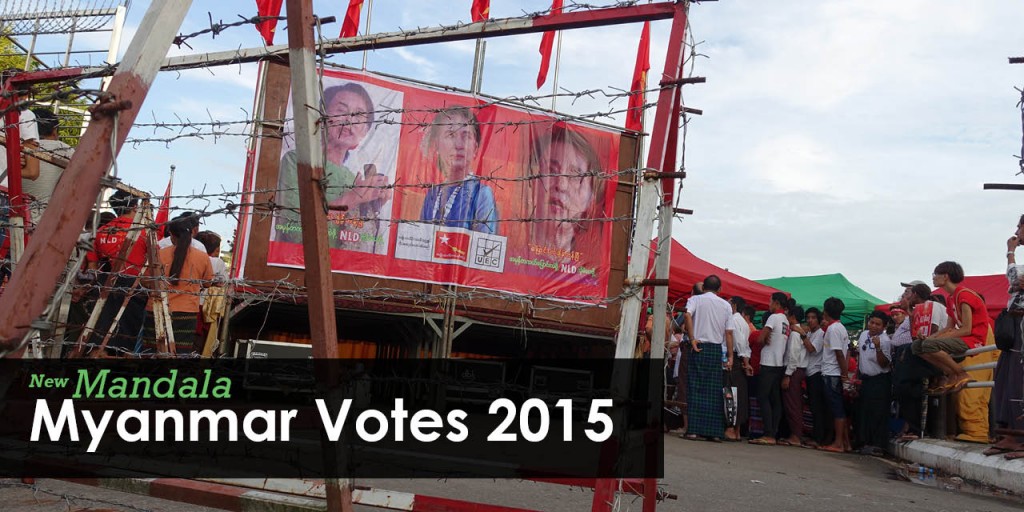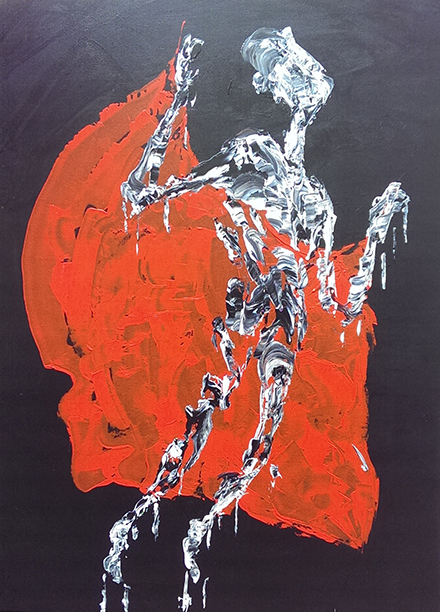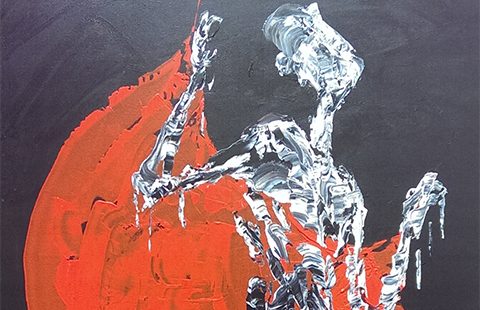
The end of censorship and elections have seen the flourishing of artistic expression in Myanmar. But there are still risks.
Over the last month visual art in Myanmar has taken on a singular colour palate – and it’s all red. This may bypass many observers, even though it represents yet another major change in Myanmar that has happened over the last two years.
Prior to the 2013 reform of censorship laws, all works proposed for public exhibition were vetted by government censors. Works would be rejected for random reasons, there was little consistency, and there was no avenue for appeal.
While never explicitly said, red (along with black and white) in a painting would always attract the censor’s close scrutiny. No matter that it might be used as a realistic depiction of an object, red was seen as a symbol of subversive thought.
Was the artist commenting on the civil bloodshed that continued to occur? Was it referencing the National League for Democracy and Aung San Suu Kyi? Was it simply seen as a colour that represented a destabilising force and therefore threatened Government control?
Quite frankly, who knows and does it really matter right now? What does matter is that artists across all areas of creative practice – visual artists, writers, poets, performers – have been subject to harsh and punitive treatment for expressing populist thought in a singular and public voice.
After the 1988 elections, artists were quickly arrested, their professional outputs being seen as very public symbols of dissent. In the ensuing decades public art was severely censored. For any of us venturing into a gallery in Yangon, the artworks on display were all ‘safe’ subjects – images of temples, scenes of daily life, experimental abstracted works – and there was very little red.
The 2013 reforms gave artists greater public freedom under law. Yet movement into this new untested realm of ‘non-censored’ art has been tentative. It has of course been much more than about legislation, it has been about trust – trust in systems that had for many years failed to deliver consistent outcomes.
An artist wishing to make a living out of selling works to a market that was essentially made up of Western buyers had to display their work in public spaces to be visible. This made them subject to the censor scrutiny. Artists were faced with difficult choices – paint acceptable subjects, or risk the removal or destruction of their works, or at worst, imprisonment.
This is not to say all artworks produced were banal. Indeed, we can read many subtle signs of political commentary and nuances in imagery which references social and political concerns, just as we see in contemporary art worldwide. And of course, artists did not stop producing political art, the works were just not displayed in public.
An exhibition held in Hong Kong in 2014, ‘Banned in Burma; Painting under censorship’, organised by Professor Ian Holliday and Melissa Carlson, showcased paintings artists created prior to 2013 that would never have passed the censor’s review.

One of the works in Aung Soe Min’s ‘Crisis in Buddhism’ series.
Looking at the last two years, the public display of art has been on a slow boil, with artists and gallery owners gaining confidence in pushing the old boundaries. For me, the artworks I’ve seen over this time have been steadily getting more hard edged. Well-known artists like Htein Lin and Aung Soe Min have embarked on projects that have direct political references.
Htein Lin’s recent project ‘Show of Hands’ was a display of 400 casts of hands and forearms from former political prisoners living in Myanmar, and Aung Soe Min exhibited a series called ‘Crisis of Buddhism’ early this year with large scale canvases of red, black and white showing disintegrating monks. The success of exhibitions like these seem to have pushed the slow boil to boiling point.
Now, on the threshold of Myanmar’s election, it is extraordinary to see the type of artworks that are being displayed in the many art galleries in Yangon in the last few months. Images of Aung San and Aung San Su Kyi, previously ‘no go’ subjects, are everywhere. Red is seen all over canvases, often in an overt depiction of the NLD flag.
The use of social media has exploded and the reach of artistic production is unprecedented. Search for a Myanmar artist’s Facebook page (most have them) and try finding one without political comment. However, there is still a sense of risk and uncertainty.
In Hong Kong, Carlson has curated another exhibition ‘Burma by proxy: art at the Dawn of Democracy’ showing works by around 50 artists who have overtly expressed their hopes and fears leading up to the election, on canvas. In Yangon there has not been a consolidated exhibition with the same uniting theme.
History has shown the power of artists in portraying popular opposition to unjust and unpopular governance. History has also shown the risks that artists take by putting themselves in the public eye, and the punishment that can be wrought. As the rhetoric and tension around this weekend’s election heats up, the sense of risk is rising.
Whatever the outcome – let’s keep the red on the canvas, as an emblem of artistic freedom.
Dr Charlotte Galloway is Lecturer in Asian Art History and Curatorial Studies at the Australian National University’s College of Arts and Social Sciences.
This article forms part of New Mandala’s ‘Myanmar and the vote‘ series.
 Facebook
Facebook  Twitter
Twitter  Soundcloud
Soundcloud  Youtube
Youtube  Rss
Rss 